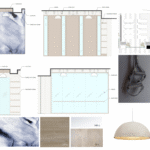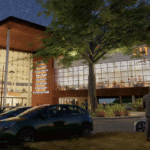
7 Considerations for Large-Scale Interior Signage & Wayfinding
Whether you are opening a new business or rebranding your current one, signage needs to be one of the top considerations in your planning process. Your signage not only tells people about your brand, from your product offerings to the locations of various departments, but also can increase the value leading to greater profits. Without clear interior signage, you can potentially lose customers because of poor experiences.
Commercial interior signage should be developed carefully and thoroughly. You can save time and money by putting together your signage once in one cohesive unit instead of assembling your materials piecemeal. Keep reading to understand our seven key principles for interior signage fabrication and how you can apply them to your business.
1. Size
One of the first things people think about with signage is size. Some customers want signs that you can see across the store while others want a subtle experience. There is one key myth to bust in regard to signage, that big signs are expensive.
Your budget does not have to dictate how big or small your signs are. You can create a large sign and use a variety of materials to keep your budget in place. Start with a vision and then work around a budget.
2. Materials
Once you have an idea for the sizing of your interior signage, it’s time to move on to the materials. In 2021, more customers are opting for faux finishes, or materials that look like wood, metal, and stone but actually aren’t. This is what we mean by affordable signage.
Faux finishes are just one element of the materials you can use. You can also play with backlighting and uplighting (even for interior signs) as well as sign positioning. There are dozens of materials to choose from the help your signage dreams become a reality.
3. Branding
While the size and materials that you choose will reflect your brand, this element deserves a section of its own. Your brand needs to be reflected in every aspect of your business, from the first impression customers have to the fleeting memories when they leave. In the modern era of experiential shopping, every business needs to use its brand to immerse customers.
For a great example of thorough branding in signed, look at the Sarasota Modern Hotel, an 89-Room luxury boutique hotel. We did all of the signage on their property, which gave us the power to make sure each sign we created matched the brand. When walking through the hotel, the signage reflects a classy modern feel. There are vinyl graphics, neon tubing in the entrance and in the restaurant, and minimalist fonts used to guide people to their rooms. Every design element ties back to the brand.
4. Contrast
While your brand is a key part of the design process, there are also basic color psychology elements that determine what makes signage look good. In particular, color contrast is easier on the eyes (creating a better experience) while also making your signage more accessible.
There are multiple ways to include contrasting elements in your signage while protecting your brand. You can choose backing materials that contrast against your key colors or play with lighting that highlights your words or logo.
“Often, people assume a difference in color is what creates contrast, but that’s not true,” says Ashton Hauff at CoSchedule. “You might have two colors that are completely different but have no contrast at all because their tone is the same.”
You don’t have to sacrifice your brand to create contrast, and the contrasting elements you add can make a big difference in how customers engage with your business.
5. Content
With all of the excitement around branding and colors, it’s easy to forget about content. However, the signs you create can have a significant impact on the customer or visitor experience.
This is something we see often when we work with hospitals and other healthcare providers. When we designed signage for Joe DiMaggio’s Children’s Health Specialty Center in Wellington, Florida, we had to create content with the customer in mind. The signage we created would reduce confusion for scared or exhausted family members so they could easily get to their kids. The signage was also welcoming so the kids felt calm and the parents knew they could trust the center.
Our focus on content helped us install both exterior and interior signage, including wayfinding and room markers.
6. Flow
Wayfinding is important for guiding people to where they need to go – everyone wants to find the exit in a parking garage or locate the bathrooms when nature calls. However, this practice also creates a sense of flow.
“Everyone’s in a hurry these days,” says Kathy Heil at Palmer Retail Solutions. “The ideal store layout feeds their desire for efficient navigation while allowing you to show off your merchandise.”
Good wayfinding guides people from one section of your business to the other in a natural pattern. This takes more than just design elements, this takes an understanding of human psychology.
Flow is a key element of interior signage because it keeps people moving (especially if you operate a hospital where visitors are easily lost) and it keeps people shopping if you operate a retail location. Flow can also help your customer service team as they will field fewer questions from lost customers.
7. Inclusion
Many people (our design team included) focus on accessibility when considering the needs of others. In signage, this might mean adding a Braille element to a wall sign and placing it closer to the ground. However, this signage isn’t inclusive. It helps a few people with a few specific conditions.
“An important distinction between accessibility and inclusive design is that accessibility is an attribute while inclusive design is a method,” says Jaime Singer, a UX designer. This includes all genders, races, and abilities.
At Creative Sign Designs, we are working to become more inclusive from the start, building in accessibility features to help visitors and customers from all backgrounds and to create comfortable experiences for all.
We Can Develop Your Signage Strategy
At Creative Sign Designs, we can help you design, print, and install your interior signage. We work on large-scale commercial projects for major hospitals and business centers, along with small projects for local shops. Our goal is to help your signage shine so you can win customers over and increase your profits.
Contact our experts today.




